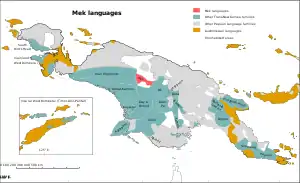Mek languages
The Mek languages are a well established family of Papuan languages spoken by the Mek peoples. They form a branch of the Trans–New Guinea languages (TNG) in the classifications of Stephen Wurm (1975) and of Malcolm Ross (2005).
| Mek | |
|---|---|
| Goliath | |
| Ethnicity | Mek people |
| Geographic distribution | New Guinea |
| Linguistic classification | Trans–New Guinea |
| Glottolog | mekk1240 |
 Map: The Mek languages of New Guinea
The Mek languages
Other Trans–New Guinea languages
Other Papuan languages
Austronesian languages
Uninhabited | |
Mek, then called Goliath, was identified by M. Bromley in 1967. It was placed in TNG by Wurm (1975).
Languages
The Mek languages form three dialect chains (Heeschen 1998):
- Eastern: Ketengban (including Okbap, Omban, Bime, Onya), Una (Goliath), Eipomek
- Northern: Kosarek Yale–Nipsan, Nalca
- Western: Korupun-Sela (including Dagi, Sisibna, Deibula)
Proto-language
Phonemes
Usher (2020) reconstructs the consonant and vowel inventories as 'perhaps' as follows:[2]
*m *n *ŋ *p *t *k *kʷ *(m)b *(n)d *(ŋ)g *(ŋ)gʷ *s *w *l *j
i u e o ɛ ɔ a ɒ
ei ou ɛi ɔu ai au aɛ aɔ
Pronouns
Pronouns are:[2]
sg pl 1 *na *nu[n] 2 *kan *kun (?) 3 *ɛl *tun, *[t/s]ig
The difference between the two 3pl forms is not known. 2pl and 3pl have parallels in Momuna /kun tun/.
Basic vocabulary
Some lexical reconstructions by Usher (2020) are:[2]
gloss Proto-Mek Proto-East Mek Kimyal Proto-Northwest Mek Proto-Momuna-Mek Momuna hair/feather *p[ɔ]t[ɔ]ŋ *pɔtɔŋ osoŋ *hɔŋ ear/twelve *aᵓ ɔ *aᵓ eye *atiŋ *asiŋ isiŋ *haⁱŋ *ɒtig ɒtù tooth/sharp *jo̝ *jo̝ jó tongue *se̝l[ija]mu *[se̝]l[ija]mu selamu *se̝l[i]mu foot/leg *jan *jan jan *jan *j[a/ɒ]n blood *e̝ne̝ŋ *ɪnɪŋ eneŋ *e̝ne̝ŋ *jo̝ne̝g bone *jɔk *jɔk jw-aʔ *jɔʔ[ɔ] breast *mɔᵘm *mɔᵘm moᵘm *mɔᵘm *mɔᵘm mɒ̃ᵘ louse *ami *ami imi *ami *ami ami dog *gam *[k/g]am gam *gam *gɒm kɒ̀ pig *be̝sam *bɪsam *bham wɒ́ bird *mak, *mag *mak -ma (?) *-ma (?) *mak má egg/fruit/seed *do̝[k] *dʊk do *do̝[k] dɒko ~ dɒku tree/wood *gal gal *gal *gɒl kɒ̀ woman/wife *ge̝l *[k/g]ɪl gel *ge̝l sun *k[ɛ]t[e̝]ŋ *k[ɛ]t[ɪ]ŋ isiŋ *he̝ŋ moon *wal *wal wal *wal water/river *m[ɛ/a]g *mɛk mag *m[ɛ/a]g fire *o̝ᵘg *ʊᵘk ug *[u]g stone *gɛⁱl; *gidig *[k/g]ɛⁱl girig *gidig kè path/way *bi[t/s]ig *bi[t/s]ik bisig *bhig name *si *si si *si *si si eat/drink *de̝-(b) *dɪ-(b) de- *de̝-(b) de- one *[na]tɔn *tɔn nason *nhɔn two/ring finger *b[e̝/ɛ]te̝ne̝ *b[ɪ/ɛ]tɪnɪ besene *bhe̝ne̝
Vocabulary comparison
The following basic vocabulary words are from McElhanon & Voorhoeve (1970),[3] Voorhoeve (1975),[4] and Heeschen (1978),[5] as cited in the Trans-New Guinea database:[6]
gloss Eipomek Korapun-Sela Nalca Una Yale, Korsarek Ketengban head kiisok asak huk heiyɔ´; khe yok giso hair fotong asuŋ hoŋ otoŋ hong; hɔŋ potong ear amol amalé amol eye asing isiŋ hiŋ atsiŋ heiŋ; hɩng asorue nose uu uryam u tooth sii si si tsi si tsi tongue sii tang selemú lyemngwe leg yan saŋ yan yan yan louse amnye wutnavu amnya ami; ami´ amnye dog kam kʰam; kham kam kam kam pig basam pham pham uduk pam; pham besam bird make winaŋ winiŋ mai winang; winaŋ ma egg duk waŋga doug winaŋ wana; winang wangká do blood ining iniŋ iniŋ eneŋ; ining yabye bone yoke iaŋ birin yog yok; you yo skin boxa phok kon breast taram saram taram tree yo kal; khal kal; khal kal co man nimi nim nimi woman kilape kəlabo nerape sky iim im im sun ketinge isiŋ hiŋ hein; hɛng getane moon wale wal ware water mek mak mek meye mak me fire uukwe uk uk uke ouk̂; ow ukwe stone kedinge khirik kirik waliŋ kirik gil road, path biisiik bi bisi name sii utnimi si si si eat dibmal dilom kwaːniŋ el dilamla; tiu loŋa jibmar one ton thoxunok nhon otunohon; se'lek tegen two bisini phein pɛndɛ; phende bitini
Evolution
Mek reflexes of proto-Trans-New Guinea (pTNG) etyma are:[7]
- mun ‘belly’ < *mundun ‘internal organs’
- kuna ‘shadow’ < *k(a,o)nan
- saŋ ‘dancing song’ < *saŋ
- getane ‘sun’ < *kVtane
- mundo ‘belly’ < *mundun ‘internal organs’
- ami ‘louse’ < *niman
- si ‘tooth’ < *(s,t)i(s,t)i
- tomo < *k(i,u)tuma ‘night’
- de ‘to burn’ < *nj(a,e,i)
- mon ‘belly’ < *mundun ‘internal organs’
- xau ‘ashes’ < *kambu
References
- Momuna–Mek, New Guinea World
- New Guinea World
- McElhanon, K.A. and Voorhoeve, C.L. The Trans-New Guinea Phylum: Explorations in deep-level genetic relationships. B-16, vi + 112 pages. Pacific Linguistics, The Australian National University, 1970. doi:10.15144/PL-B16
- Voorhoeve, C.L. Languages of Irian Jaya: Checklist. Preliminary classification, language maps, wordlists. B-31, iv + 133 pages. Pacific Linguistics, The Australian National University, 1975. doi:10.15144/PL-B31
- Heeschen, V. 1978. The Mek languages of Irian Jaya with special reference to the Eipo language. Irian 2: 3-67.
- Greenhill, Simon (2016). "TransNewGuinea.org - database of the languages of New Guinea". Retrieved 2020-11-05.
- Pawley, Andrew; Hammarström, Harald (2018). "The Trans New Guinea family". In Palmer, Bill (ed.). The Languages and Linguistics of the New Guinea Area: A Comprehensive Guide. The World of Linguistics. 4. Berlin: De Gruyter Mouton. pp. 21–196. ISBN 978-3-11-028642-7.
- Ross, Malcolm (2005). "Pronouns as a preliminary diagnostic for grouping Papuan languages". In Andrew Pawley; Robert Attenborough; Robin Hide; Jack Golson (eds.). Papuan pasts: cultural, linguistic and biological histories of Papuan-speaking peoples. Canberra: Pacific Linguistics. pp. 15–66. ISBN 0858835622. OCLC 67292782.
External links
- Timothy Usher, New Guinea World, Proto–Momuna–Mek
- (ibid.) Proto–Mek
